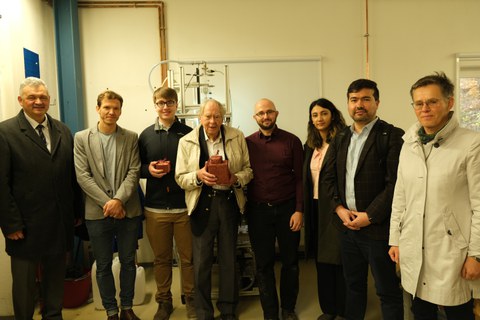Dec 08, 2023
Prof. Graeme Jameson visits Prof. Kerstin Eckerts department at HZDR
Prof. Dr. Kerstin Eckert's Chair of Transport Processes at Interfaces at the Helmholtz-Zentrum Dresden-Rossendorf (HZDR) welcomed an extraordinary scientist in November: Following the 11th International Flotation Conference in Cape Town, 87-year-old Australian Professor (emeritus) Graeme Jameson visited the HZDR to discuss the basic principles of the Concorde CellTM in the flotation of very fine ore particles. Scientists from the Institute of Fluid Dynamics (FWD) and the Helmholtz Institute Freiberg for Ressource Technology (HIF) took part in the discussion. Prof. Jameson was accompanied by two Concorde Cell specialists from Finland who work for Metso.
Froth flotation is one of the most important discoveries of the 19th century. It is attributed to the mining engineer and geologist Charles F. K. Bührer. It is a mineral processing technique used to extract valuable minerals from ores by separating them by forming a froth on the surface of a liquid.
In the 20th century, this process was further developed, making flotation the most important method in the mining industry today for extracting valuable raw materials from ores. One of the best-known faces of this process worldwide is Professor Jameson, the inventor of the Jameson cell. This is regarded as Australia's most successful innovation of the last 25 years and is licensed by Glencore Technologies. Every year, several billion tons of ore are extracted worldwide using flotation, including copper, nickel, platinum, silver and zinc.
Professor Jameson's refinements to the Jameson cell led to the invention of the Concorde cell, which proved particularly promising for the separation of very small mineral grains (less than 30 microns).
In Prof. Dr. Kerstin Eckert's Department of Transport Processes at Interfaces, Dr. Till Zürner, a young scientist in the HZDR High Potential Program, is responsible for the demonstrator of a Concorde-like cell. Zürner uses a simplified model geometry to investigate the so-called "plunging jet", the immersive water jet loaded with particles that flows simultaneously with air into the flotation cell. "A special feature of the Concorde cell are the constricting nozzles at the beginning and end of the Concorde Blast Tube™. They compress the flow of particles and air bubbles and increase the turbulence," explains Dr. Zürner, who visited Metso's research center in Finland last October. The scientist's aim is to achieve the speed of sound in 2- and 3-phase flow in his Concorde-like cell - hence the name of the flotation cell.
Scientific studies of multiphase flow in the lower part of the flotation cell have been rare because it is becoming increasingly difficult to visualize the interaction between small model particles and the equally tiny gas bubbles at high flow rates. Together with the Department of Computational Fluid Dynamics, Prof. Dr. Kerstin Eckert and her research group are looking for ways to make the invisible visible using optical and electrical tomography, pressure sensors and other sensors and software programs currently under development.
The Finnish company Metso, one of the world's leading suppliers of flotation technology, is also showing great interest in this data. A research collaboration between the HZDR and Metso was recently initiated through the HZDR alumni network.
The visit with Prof. Jameson was a great opportunity to take a look at the test apparatus at the HZDR and to engage in a professional exchange. "There are so many questions for us that can only be clarified in a direct exchange of knowledge with Prof. Jameson and the colleagues from Metso. This visit is invaluable for us," says Prof. Dr. Kerstin Eckert.
(Press Release: "Prof. Graeme Jameson, inventor of flotation cells, visits Prof. Kerstin Eckerts department at HZDR", 17.11.2023)

